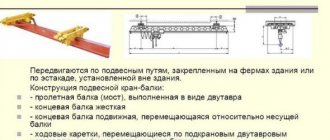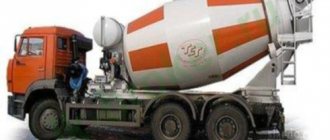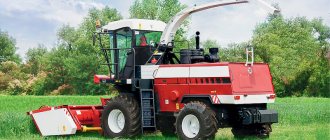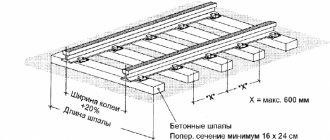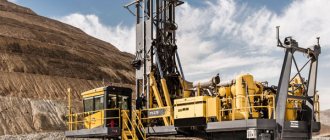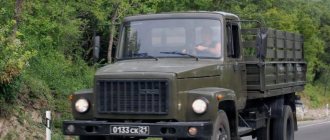One of the types of overhead crane is a beam crane. It has become widespread due to its versatility of use. The beam crane is used at production and construction sites, in warehouses, and is indispensable when installing or dismantling various structures.
The device is intended for use in rooms of appropriate size, as well as under awnings or in the open air. The overhead crane is designed to withstand adverse weather conditions and can operate in a temperature range from -40°C to +40°C. Designed to safely carry loads in vertical and horizontal directions. Features simple controls. Made from durable metal alloys that are not afraid of high loads.
General device
If we compare the described variety with overhead cranes, the differences are noticeable to the naked eye. The design of the beam crane includes:
- device for lifting loads (lift);
- a span beam that guides the movement of the structure;
- two end beams guiding the movement of the crane.
The beam crane is usually mounted under the ceiling of a warehouse or production workshop, where it carries out its assigned task. It works reliably, without creating unnecessary noise, ensuring high productivity.
Used in docks and hangars, storage facilities, workshops. However, beam cranes are used in almost all industries, both light and heavy. This is a universal design, constantly used in production.
Material and assembly units
If we talk about the requirements for the material, then all components must be made of steel, the mechanical properties of which, including impact strength, chemical composition, and weldability, will meet the operating requirements specified in GOST. It is also important to note that the operability of the structure must be ensured in the following temperature ranges: from +40 to -40 degrees Celsius, or from +40 to -20 degrees Celsius.
Another important requirement is that cranes can only be made from steel that has a certificate confirming their quality.
The document also contains several requirements regarding the assembly units from which the crane is assembled. For example, one of the points says that the assembled model of equipment, which does not carry a load, must completely touch the tracks with the wheels of the carts. One of the requirements concerns such an assembly unit as a double container. Defects such as potholes or dents are allowed on the working surface of the lower shelf of this assembly unit, but only if their depth does not exceed 1 mm.
Features and characteristics of the support crane beam
The design of this type includes: a load-bearing beam, end beams, and a control system. May be electric or manual depending on the specific configuration. Such a crane beam rests on a specially equipped crane track, moving along rails from above. It is safe, highly effective, and versatile in terms of use.
When using the described option, there is no need to limit the length of the rail tracks, and the overpass itself becomes independent. Plus, a load of much larger tonnage is captured and lifted than that of suspended structures with identical parameters.
It is controlled in two ways: by manual drive, when human physical strength is used, or by electricity. The first option is less productive because it requires more labor, plus it is unprofitable when working with heavy loads. Electric overhead cranes easily cope with tasks corresponding to their technical characteristics and do not require human effort. Most often found in premises with relatively small areas: production workshops, warehouses, hangars, ports.
How is an electric hoist used as a lifting mechanism?
It happens that the crane production mechanism does not use butt locks, but then there is always a cable for powering the electric hoist.
The load-handling mechanism moves along the transverse beams
To increase the service life of suspended tracks and running wheels, the supporting beam and one of the end beams are movably connected, thus making it possible to change the span of the crane.
This mechanism makes it easier to self-install the model on the tracks when the crane passes uneven sections of the suspended track.
The lifting capacity of such a model ranges from 1 to 5 tons, the span is 3 – 15 m, and the consoles have a length from 150 to 300 cm. The main purpose of the electric single-girder overhead bridge crane is to mechanize loading and unloading work.
Features and characteristics of the overhead crane
Suspended crane beams differ only in that they are attached not from above, but from below the cargo tracks. They are divided into single-span and double-span. The design of the former includes two end beams, and the latter - three.
With this arrangement, the main load falls on the lower part of the crane runway, which negatively affects the lifting capacity. However, there is a significant advantage that must be taken into account if you are going to make the most of your warehouse space.
Suspended models do not require support columns, so they can easily be moved along areas along the walls, and not just under the ceiling. The described device has no “dead” zones, and if the production does not involve lifting loads of more than 10 tons, a suspended beam crane is a more suitable option, although it is more expensive.
Comparative characteristics:
| Support mechanism | Hanging mechanism |
| Load-bearing structures - supports located under the ceiling, the crane beam is mounted on top of them | Serves the entire workshop area, including vertical surfaces. |
| Increased load capacity | It is possible to operate two devices simultaneously. |
| Ability to change speeds | Limited load capacity |
| Due to the need to install columns and crane tracks, the movement area is limited. | Supporting structures are the vulnerable part of the device. |
Despite some differences, suspended and support crane beams have common characteristics that have ensured their widespread use:
- ease of installation, management, operation;
- compactness (some models are suitable for small spaces)
- low maintenance requirements;
- load capacity (depending on the specific model);
- affordability.
In addition, the market offers an impressive variety of device configurations, from which you can always choose the one that suits you. Often, a manufacturing plant produces a product tailored to specific customer requirements, which also makes beam cranes popular.
Installation design
A separate paragraph in the document contains all the requirements for the design features of such machines.
- If the customer so requests, the products must be additionally equipped with devices such as a system for remote control of equipment via a radio channel. In some cases, a single-wire type communication line may be used.
- Another point, which is also carried out only if the customer requires it, is to supply electric cranes with additional systems that ensure smooth descent of the mechanism, and will also make it possible to regulate the speed of lifting and lowering.
- Another quite important requirement that must always be met, regardless of the customer’s wishes, is the transportability of the crane components. In other words, equipment assembly should be carried out not at the factory, but at the installation site, and the manufacturer’s task is to produce assembly parts of the structure.
Drive types
As mentioned above, the drive of such devices can be manual or electric. If you compare the price, the first option is more profitable. However, moving such a beam crane requires human effort. This is why it will not be possible to lift heavy, multi-ton loads; moreover, productivity will be much lower compared to an electric drive. In modern workshops, the described options have long been considered outdated and ineffective.
Electrically driven overhead cranes are more productive and convenient to use. They do not require the slightest human effort. The load is moved through the coordinated operation of the electric motor, gearbox and transmission shaft. The devices in question easily lift heavy loads and have the following operational advantages:
- high labor productivity;
- low labor costs;
- intensity of technology use.
When choosing a drive, consider all of the above, plus: electric drive cranes are heavier and more expensive. If you do not intend to constantly use the devices, as well as move multi-ton products, a manually driven design is suitable.
Main parameters according to GOST
The main types of manufactured cranes in accordance with GOST 7890-93: single-beam overhead cranes, single-span or double-span.
If the electrical device has a load capacity of 1; 2; 3.2; 5 t, then the maximum lifting height for it will be 6; 12; 18; 24 and 36 m respectively. Further, if the crane’s load capacity class is 8 tons, then its height can be of three types - 12, 24 or 36 meters. Another group of electric machines with a maximum lifting capacity of 10 tons can have lifting heights of 18, 24, 36 meters. These parameters apply to automatic overhead electric overhead cranes.
If we talk about the main standard sizes for manual drives, they are as follows: equipment with a load capacity of 1; 2; 3.2; 5t should have a maximum lift height of 3, 6, 9 and 12 meters respectively.
Another important parameter, which is also regulated by a state document, is the speed of movement of the crane. The nominal value of this characteristic is from 0.32 m/s to 0.53 m/s.
Principle of operation
Regardless of which model and configuration of the crane beam is used, the principle of operation is the same for all. Consists of four stages (operations):
- Grab and lift. The overhead crane takes the load and then fixes it at the height initially set by the operator.
- Moving. The device transfers a load from point A to point B.
- Unloading. Having delivered the materials to the specified location, the crane lowers to the designated height. The device is unloading.
- Return to starting position.
The design of beam cranes is so simple and effective that they are used everywhere, without requiring complex maintenance or a specially organized complex workspace. It is enough to create guides along which the described equipment will move, and install it correctly.
Hoist control
The hoist is also controlled using special buttons. In order to direct it to the left, you need to close the corresponding contact. The current will flow through it through the limit switch located at the extreme left point of the hoist.
When the limit position is reached, the target feeding the starter will open and movement will stop. How to determine this moment? When the hoist collides with the rubber buffer. This mechanism protects the electric motor from overload and also protects the wheels from rapid wear, preventing them from rotating aimlessly while in one place.
The right direction works in a similar way.
Installation
Only specialists should install the crane beams, as installation requires compliance with safety precautions. A lot of time is spent on installing a beam crane, since the structure consists of a large number of parts. Before starting work, specialists assess the premises, its design features, and the location of the crane itself. Next, deadlines are set, as well as the need to use additional auxiliary tools.
Installation of the crane beam can be carried out using different methods. First, you can install the crane tracks and only then assemble the crane parts element by element. Or assemble the crane beam on a special site and transport it to the desired location.
Equipment reliability
According to GOST, single-girder overhead overhead cranes must be in operation for at least 20 years. If we talk about mean time between failures, the equipment must withstand at least 3000 cycles.
When determining the time between failures for such devices, this does not include failures that were caused by minor faults. This category includes, for example, failure of equipment due to the operation of an electrical protection device, burnout of electrical warning lamps, etc.
Introduction
This standard establishes general technical requirements for the design of overhead and gantry (semi-gantry) cranes at the design and manufacturing stages. The provisions of the standard can also be implemented during the reconstruction and modernization of these machines.
Application of the provisions of this standard on a voluntary basis can be used to confirm and assess the compliance of load-lifting cranes with the requirements of the Technical Regulations of the Customs Union “On the safety of machinery and equipment”.
Preface
The goals, basic principles and general rules for carrying out work on interstate standardization are established by GOST 1.0 “Interstate standardization system. Basic provisions" and GOST 1.2 "Interstate standardization system. Interstate standards, rules and recommendations for interstate standardization. Rules for development, acceptance, updating and cancellation"
Standard information
1 DEVELOPED by Joint Stock Company "RATTE" (JSC "RATTE")
2 INTRODUCED by the Federal Agency for Technical Regulation and Metrology
3 ADOPTED by the Interstate Council for Standardization, Metrology and Certification (protocol dated September 30, 2022 N 122-P)
The following voted for adoption:
Short name of the country according to MK (ISO 3166) 004-97
Abbreviated name of the national standardization body
State Standard of the Republic of Belarus
4 By Order of the Federal Agency for Technical Regulation and Metrology dated October 9, 2022 N 940-st, the interstate standard GOST 34589-2019 was put into effect as a national standard of the Russian Federation from June 1, 2022.
Information on the entry into force (termination) of this standard and amendments to it on the territory of the above states is published in the indexes of national standards published in these states, as well as on the Internet on the websites of the relevant national standardization bodies.
Mechanisms for moving cargo trolleys
Mechanisms for moving trolleys and cranes along a rail track are often with drive wheels, and less often with rope traction (it is usually used exclusively for cargo trolleys).
Drive wheels can be with separate or central drive. The rotation of wheels with a central drive is performed by one engine through a transmission (intermediate) shaft.
In a split drive, the driven two-wheeled undercarriage or each wheel is equipped with its own motor.
